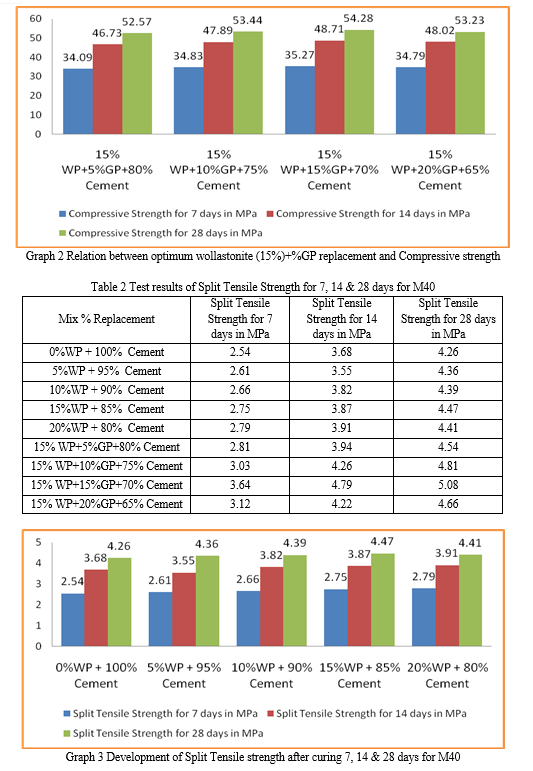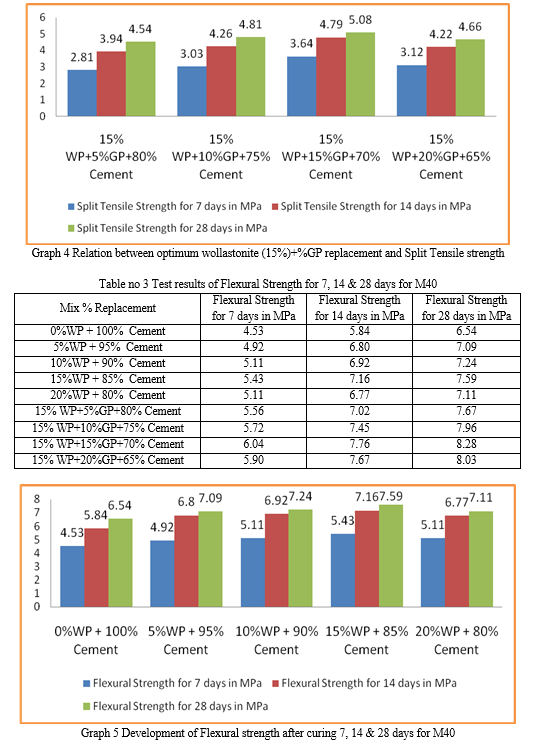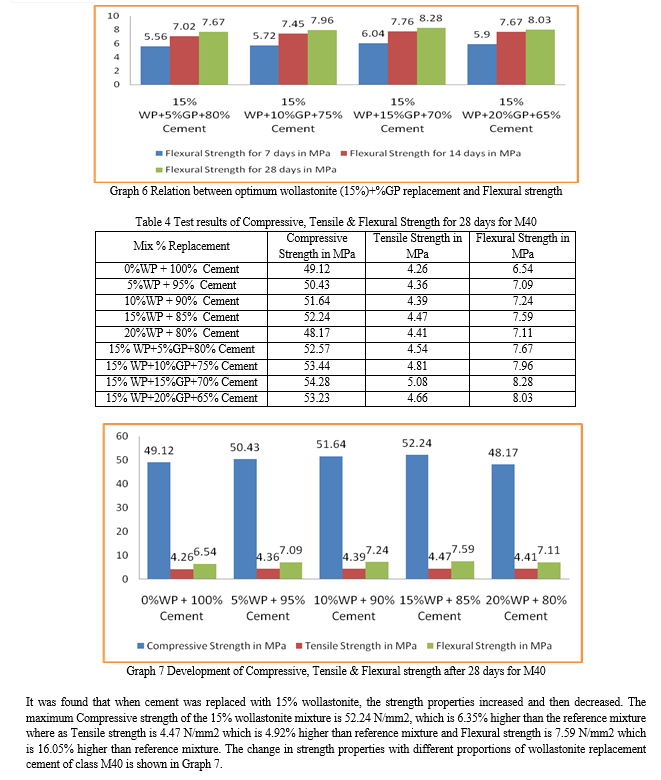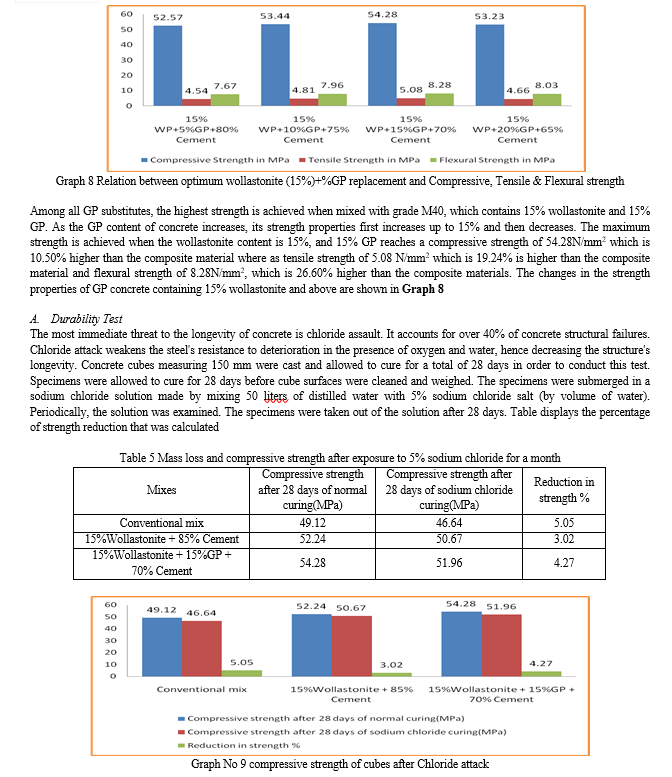Ijraset Journal For Research in Applied Science and Engineering Technology
- Home / Ijraset
- On This Page
- Abstract
- Introduction
- Conclusion
- References
- Copyright
Impact of Wollastonite and Glass Powder as Partial Cement Replacement on the Properties of Concrete
Authors: Pothuru Sucharitha, Jollireddy Omprakash
DOI Link: https://doi.org/10.22214/ijraset.2024.63634
Certificate: View Certificate
Abstract
Scientists are currently concentrating their efforts on waste products, agricultural waste, and other natural elements in an effort to develop technologies that might be utilized as raw materials for construction. Recycling, on the other hand, stimulates the economy and contributes to the creation of a cleaner, safer environment. To solve this problem, a variety of ingredients are used in place of some cement, such as fly ash, GGBS, silica fume, wollastonite, waste glass powder, etc. You can cut down on pollutants in the environment by replacing part of the cement with wollastonite and glass powder. Since glass does not biodegrade, filling it with shattered glass is an unsustainable and damaging activity for the environment. Silica makes up the majority of glass. Wollastonite is a naturally occurring material that costs less than cement. This study\'s main goal is to investigate possible impacts and determine how the wollastonite-glass powder (W-GP) combination influences the mechanical properties and longevity of M40-grade concrete. We study the properties of concrete strength after adding wollastonite at 5%, 10%, 15%, and 20%. In order to maintain the optimal percentage of wollastonite replacement, mineral admixtures such as glass powder (5%, 10%, 15%, and 20%) can be used in place of more cement. Test results show that utilizing cement instead of 15% wollastonite yields superior outcomes to employing the recommended mixture. The mixture that demonstrated the largest strength enhancement was composed of 15% wollastonite and 15% GP.
Introduction
I. INTRODUCTION
Concrete is a highly prevalent substance on a global scale. The imperative to decrease energy use is growing as a result of the phenomenon of global warming. The impacts of global warming have already permeated the lives of individuals worldwide and are well recognized. The process of cement manufacture necessitates a substantial amount of energy, resulting in the emission of significant quantities of carbon dioxide (CO2) and the generation of carbon monoxide. Nevertheless, the manufacturing process of Portland cement, which is a primary ingredient in concrete, emits significant quantities of carbon dioxide, a potent greenhouse gas. Specifically, the manufacture of one ton of Portland cement clinker typically yields around one ton of carbon dioxide and other greenhouse gases. Greenhouse gasses (GHGs). The atmospheric concentration of carbon dioxide has risen by over 30 percent during the past two centuries. The cement and concrete industry's sustainable growth is significantly influenced by environmental concerns. To minimize cement usage and mitigate environmental pollution, it is necessary to substitute certain portions of cement with volcanic ash components. Approximately 111 million tons of managed trash from domestic, commercial and industrial garbage are thrown in UK landfills each year, raising waste disposal costs and environmental issues. Using recycled products will help you save landfill space and disposal expenses. Using recycled materials uses less energy than virgin resources.
More recently, research has been done on the impact of acrylamide in situ polymerization on the microstructure and mechanical characteristics of a particular quaternary system. In the current investigation, wollastonite powder and glass powder were combined to create a ternary blended mix.
Currently, several research have employed Portland cement, granular blast furnace slag (GGBS), marble powder, etc. instead of fly ash (PFA), ceramic powder, etc. Various waste items such as are used. Like PFA and GGBS, glass powder (GP) may be used as a binder, substituting cement, which partially reacts when hydrated, and is used as a filler. Glass trash, when crushed into a very fine powder, exhibits pozzolanic qualities due to the presence of SiO2 and can thus, to some degree, substitute cement in concrete, helping to boost strength and improve properties over lengthy periods of time. Glass has significant silica content, hence it will transform into volcanic ash when the particle size is less than 75µm. The function of recycled glass trash in Portland cement and concrete has attracted tremendous attention globally due to disposal costs and environmental concerns. The glass used for containers, jars and bottles is soda-lime-silica, which accounts about 80% of recycled glass.
The word glass encompasses numerous distinct compounds, such as binary alkali silicate glass, borosilicate glass, and ternary soda-lime silicate glass. Glass has existed in different forms for thousands of years and dates back to B.C. It is an amorphous substance that has been created for human usage since 12,000 BC. Glass is one of the most versatile materials in the world, with various uses and varieties, from clear glass to tempered and tinted glass. Due to the necessity of sustainable building, the construction community is increasingly incorporating waste or recycled resources in concrete.
II. LITERATURE REVIEW
Xavier Lopes, Supriya[1] A sturdy, well-binding substance used in building is concrete. India is the world's second-largest manufacturer of cement. For every ton of cement produced, about 1.5 tons of raw materials are required. When creating concrete, cement additives are utilized to use less cement. Silica is one of the minerals that is created when heated magma mixes with silica and limestone. In this investigation, wollastonite was utilized at rates of 0%, 10%, 12%, 14%, 16%, and 18% in place of cement in concrete. The impact of wollastonite on the tensile strength of mixed concrete in the M30 class was examined. For composite design, IS 10262 (2019) has been implemented. Compression coefficient and slump are computed to assess performance. Determine each concrete's flexural and compressive strengths. After being stored in HCl and MgSO4 solutions for 28 days, the materials' resistance to sulfates and chlorides was used to assess how durable they were. Next, a comparison is made between the outcomes of the various combinations and the concrete mixed results.
Renu Mathur and colleagues[2]. studied cementstone and cement fly ash mixture using silica as a substitute for cementitious materials and sand, respectivelyWollastonite (10%) added to the concrete mixture showed an increase in flexural strength (36-42%) and compressive strength (28-35%) in 28 and 56 days, respectively. Reducing water absorption, drying shrinkage and abrasion loss of concrete, as well as increasing resistance to alternating freezing-thaw and sulfate attacks are the advantages of wollastonite addition.
Wahab and associates[3]. Compressive, flexural, drying shrinkage, and first hardening tests were performed. Wollastonite raises the flexural strength and compressive strength to 45% and 28%, respectively, when 20% of the sand is replaced with it. The first time, this results in a 60% delay. After 28 days, the flexural and compressive strengths of the cement with a 30% wollastonite addition dropped by 17% and 35%, respectively. Wollastonite powder strengthens the material's resistance to dry shrinkage.
Dahiphale and associates[4]. Testing was done on compressive strength at 3, 7, and 28 days. Wollastonite contains silica, hence substituting it resulted in increases in compressive strength of 10%, 12.5%, and 15%. Nevertheless, utilization falls at greater percentages. In terms of strength, it has been discovered that 15% wollastonite replacement cement is optimal.
Dr. G. Vijay Kumar et al; [5]. In this study named "Glass Powder as a Partial Substitute for Cement in Concrete Production", it is pointed out that waste glass powder is employed as a cement portion in concrete and compared with traditional concrete. This study studies the feasibility of utilizing glass powder instead of cement in fresh concrete. Partially modified 10%, 20%, 30% and 40% glass powder was evaluated for 60-day compressive, tensile and flexural strength and compared to normal concrete. . The material is particle size smaller than 75um, which may inhibit alkali-silica reaction. The 28-day compressive strength of the concrete panel is 31.1 N/mm2, tensile strength is 2.27 N/mm2 and bending strength is 3.25 N/mm2. Replacing 40% of cement with glass powder was shown to boost strength by 33.7% compared to standard concrete. Tensile strength testing was also done and after substituting 40% cement, the strength rose by 4.4%. The flexural strength of concrete with partial cement substitution of 20%, 30% and 40% improved by 88.09%, 99.07% and 100%, respectively. Finally, it was found that glass powder concrete may effectively boost the compressive, tensile and bending strength compared to traditional concrete. Very finely ground materials have shown to be a very excellent material, with sufficient pozzolanic material to be employed as a semi-replacement cement.
N. Kumarappam et al. [6]. "Cement in concrete was partially replaced by glass" to evaluate the efficacy of glass powder in replacing cement concrete. Portland cement (PC) is partially modified with 0-40% glass powder. Tests include ultrasonic pulse rate, compressive strength and absorption. The findings obtained by bending the sample in water at 20°C demonstrate that a reduction in the maximum strength of the concrete and the quantity of glass powder added to the mixture is attained, around 40 mm (i.e. 0% glass) for larger slump usage. powder) up to 160 mm, with 40% glass powder. Using frosted glass decreases cement consumption and the impact of air pollution and CO2 emissions on energy demand. The glass particles in the mixed stone seems to cause the stone to crack. When the glass powder percentage is 10%, the compressive strength of the concrete is higher than the control group. When the glass powder content is higher than 20%, the strength diminishes.
Zainab Z Ismail et al; [7]. The purpose of this research is to study the synthesis of cement-containing glass powder as an additive material from glass waste derived from shattered boxes and home demolitions. In addition, the usage of glass powder instead of cement and as an additive to cement was evaluated in terms of its physical and mechanical qualities. Glass powder content comprises 0.0%, 5.0%, 10.0%, 15.0%, 20.0% and 25.0% cement by weight. Experimental results reveal that glass powder possesses pozzolanic capabilities and the use of glass powder has no major influence on the setting time and expansion of cement. Using 10% glass powder instead of cement enhances the compressive strength of the mortar by roughly 9.0%. Additionally, in general, the performance of glass powder-modified concrete can be increased by utilizing roughly 15.0% glass powder instead of cement.
III. MATERIALS
A mixture of cement or binder is added to materials or components to fill the gaps left by assembly and joints to make concrete. This experiment aims to ascertain how the wollastonite-glass powder (W-GP) combination affects the mechanical characteristics and longevity of M40 standard concrete. We looked at the strength of concrete that had 5%, 10%, 15%, and 20% wollastonite added. Increased cement can be substituted with mineral materials such as glass powder (5%, 10%, 15% & 20%), provided that the wollastonite replacement percentage stays constant. The primary components utilized in this investigation are water, fine and coarse aggregate, wollastonite-glass powder, and cement. High-quality materials that meet IS: 383-2016 standards, Conforms to IS: 383-2016 Water [Portable], Coarse Aggregate, Wollastonite-glass powder.
Class 53 Common Portland Cement, adhering to IS: 269-2015
Fine Aggregate, adhering to IS: 383-2016
Coarse Aggregate, according to IS: 383-2016
Water [ Portable]
Wollastonite & GGBS
Super plastisizer Conplast wl xtra
IV. EXPERIMENTAL INVESTIGATION
|
Normal Consistency of Cement |
34% |
|
Setting Time of Standard Cement |
Intial -37 min Final - 562 min |
|
Specific Gravity Of Cement |
3.10 |
|
Fineness Test of Cement by Sieve Analysis |
97% |
|
Soundness of Cement |
3 mm |
|
Fineness Modulus of Fine Aggregate |
4.07 |
|
Fineness Modulus of Coarse Aggregate |
3.9 |
|
Specific Gravity of Fine aggregate |
2.56 |
|
Water Absorption Test on Fine Aggregate |
1.59% |
|
Bulking of Fine Aggregate |
30.73% |
|
Specific Gravity & Water Absorption of Coarse aggregate |
2.68 & 1.68% |
|
Specific Gravity of Wollastonite & GP |
2.97 & 2.60 |
|
Size(µm) of Wollastonite & GP |
< 1 to20 & < 150µ |
|
Colour of Wollastonite & GP |
White & Grayishwhite |
V. MIX DESIGN
|
Grade |
M40 |
|
Proportion |
1 : 1.65: 3.43 |
|
W/C ratio |
0.36 |
|
Cement |
413.55 Kg/m3 |
|
Fine Aggregate |
681.86 Kg/m3 |
|
Coarse Aggregate |
1205.55 Kg/m3 |
|
Water |
148.88 Kg/m3 |
|
Chemical admixture |
4.13 Kg/m3 |
VI. PERFORMANCE TESTING AND RESULTS
An experimental study was conducted by mixing M40 quality concrete. Preparation of concrete mix for M40 grade concrete as per IS: 10262-2019. Four mixtures were prepared in which 5%, 10%, 15% and 20% wollastonite was added to the cement, respectively. It was determined that maximum strength was achieved by replacing the concrete by 15%. For this reason, the replacement of cement with 15% wollastonite was kept constant and the samples were tested by replacing the cement with additional minerals (such as 5%, 10%, 15% & 20% of glass powder). A water/cement ratio of 0.36 was used for all mixtures throughout the study. The Compressive Strength, Split Tensile Strength & Flexural strength results of M40 grade concrete after 7th, 14th and 28th days curing are tested in the laboratory. The results are tabulated and graphs are represented below.





Conclusion
Based on the above research, the following analysis was carried out on artificial concrete in which cement was partially replaced with wollastonite and the mineral additive GP. 1) As the wollastonite ratio in the Concrete changes, its workability decreases. 2) It was found that the maximum strength in the total percentage of cement modified with wollastonite occurred at 15% wollastonite. 3) Compared to other mixtures, the highest concrete properties were obtained with concrete mixtures containing 15% wollastonite and 15% GP. 4) According to the test results, it was determined that the strength of the concrete combined with wollastonite and glass powder increased better than the wollastonite concrete mixture. 5) It is seen that the use of 15% wollastonite increases the compressive strength by 6.35%, splitting tensile strength by 4.92% and bending strength by 16.05% compared to conventional concrete. 6) Compared to normal concrete, it is seen that the use of 15% wollastonite and 15% glass powder increases the compressive strength by 10.50%, splitting tensile strength by 19.24% and bending strength by 26.60%. 7) When half replaced by 15% wollastonite cement and 15% glass powder cement, it has very good resistance to chloride attack compared to conventional concrete. A. Scope Of Future Research 1) Further research can be done using the difference between various wastes and the recommended amount of glass waste& wollastonite to achieve energy; Compressive, bending strength and splitting tensile strength can be determined. 2) Instead of cement, use glass powder & wollastonite with different water-cement ratios. 3) Other concrete performance tests of other concrete qualities can be performed. 4) Research can be done on replacing coarse aggregates with glass.
References
[1] Supraxia Xavier Lopes and R. S. Chikkanagoudar (2020) Wollastonite as a Partial Cement Replacement and Its Impact on the Mechanical and Durability Properties of Concrete The International Research Journal of Engineering and Technology (IRJET) Volume 07 Issue 08 | August 2020 e-ISSN: 2395-0056 p-ISSN: 2395-0072; www.irjet.net [2] \"Mechanical properties of micro and sub-micron wollastonite fibers in cementitious composites,\" Dey V, Kachala R, Bonakdar A, and Mobasher B (2015), Construction and Building Materials, Vol. 82, pp. 351 - 359. [3] \"Strength characteristics and microstructural properties of cement mortars incorporating synthetic wollastonite produced with a new technique\" Hasan Erhan Yucel, Sumeyye Ozcan, July 2019. Elsevier Ltd. is the publisher. [4] Kannula Mohankrishna Reddy and K. V. S. Gopala Krishna Sastry (2016). utilizing wollastonite-silica fume and wollastonite-flyash to test the strength qualities of concrete Vol. 6, issue 5, October 2016, 1–12, International Journal of Civil, Structural, Environmental, and Infrastructure Engineering Research and Development (ijcseierd), issn(p): 2249–6666; issn(e): 2249–7988. [5] Mr Kartik Patel (2019) Result Of Wollastonite Then Ggbs By Way Of Part Paste Extra On The Assets Of Concrete, March 2019, Volume 6, Issue 1, International Journal of Research and Analytical Reviews, www.ijrar.org (E-ISSN 2348-1269, P- ISSN 2349-5138) [6] Experimental Study on Mechanical Properties of Concrete Including Wollastonite and Ground Granulated Blast Furnace Slag As A Partial Replacement Of Cement, Vijay Bhudiya, Abbas Jamani, 2020 Journal of Engineering and Technology: International Research, Volume 7, Issue 6, pages 4559–4567 [7] Subramani, T. and Sankar Ram, S.B. “Experimental Study on Concrete Using Cement With Glass Powder” Department of Civil Engineering, VMKV Engg. College, Vinayaka Missions University,Salem, India Vol. 05, Issue||V3|| PP 43-53” 05 (May.2015) [8] IS: 383 (Specification for >4.75mm and fine aggregates from natural sources for concrete), Indian Standard Code of Practice, 1970. [9] Mix Design, Bureau of Indian Standards, “IS 10262- 2019, Recommended Guidelines for Concrete Mix Design” Standards, New Delhi, India, 2019.. [10] Grade Ordinary Portland Cement “IS 8112:1989, Specification (First Revision), Bureau of Indian Standards, New Delhi, India, 1989” [11] Kumarappan N.(2013) P artial Replacement Cement in Concrete Using Waste Glass, International Journal of Engineering Research and Technology (IJERT) 2 (10), ISSN: 2278-0181. [12] Vijayakumar G ., Vishaliny H. a nd Govindarajulu D. (2013) “Studies on Glass Powder as Partial Replacement of Cement in Concrete Production” International Journal of Emerging Technology and Advanced Engineering Website: www.ijetae.com (ISSN 2250-2459, I SO 9001:2008 Certified Journal, Volume 3, Issue 2, February). [13] IS: 4 56-2000, Plain and Reinforced Concrete Code of Practice, Bureau of Indian Standards, Manak Bhavan, 9 Bahadur Shah Marg, New Delhi-110002. [14] BIS 383: 1970 Coarse and fine aggregate from natural sources for concrete 9th Revision, B IS, New Delhi, 1970. [15] Shetty M.S “Concrete technology”, S.Chand & company limited 2009. [16] Study of Strength and Workability of Different Grades of Concrete by Partial Replacement of Fine Aggregate by Crushed Brick and Recycled Glass Powder Tiwari Darshita Patel Anoop(2014)
Copyright
Copyright © 2024 Pothuru Sucharitha, Jollireddy Omprakash. This is an open access article distributed under the Creative Commons Attribution License, which permits unrestricted use, distribution, and reproduction in any medium, provided the original work is properly cited.

Download Paper
Paper Id : IJRASET63634
Publish Date : 2024-07-15
ISSN : 2321-9653
Publisher Name : IJRASET
DOI Link : Click Here
 Submit Paper Online
Submit Paper Online

